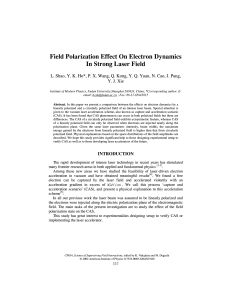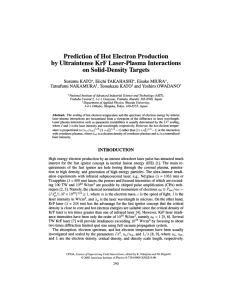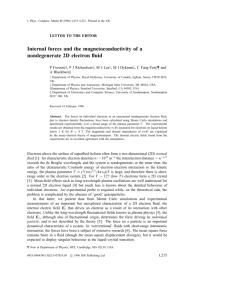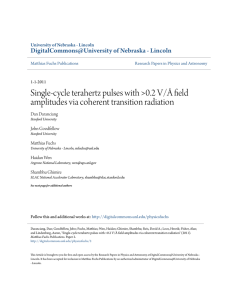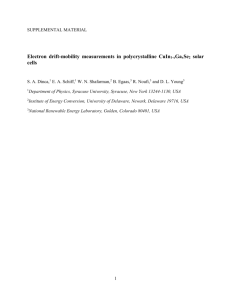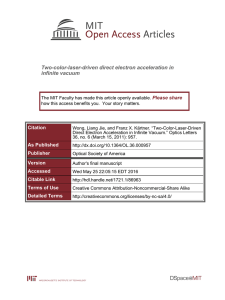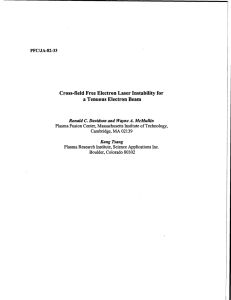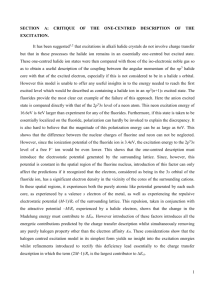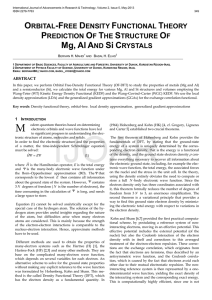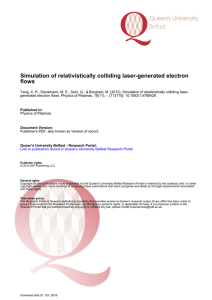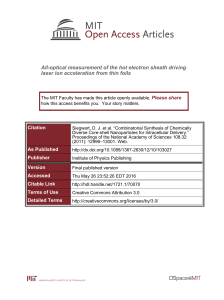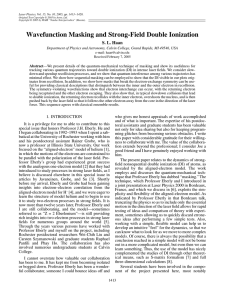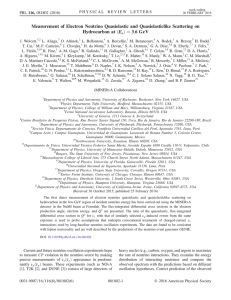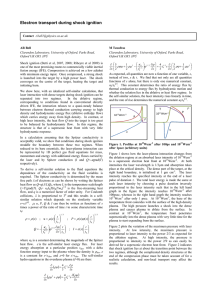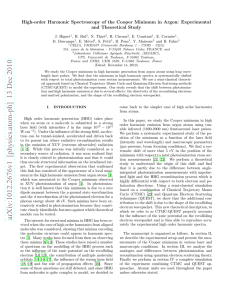Supplementary_Material_L13-01606R
advertisement
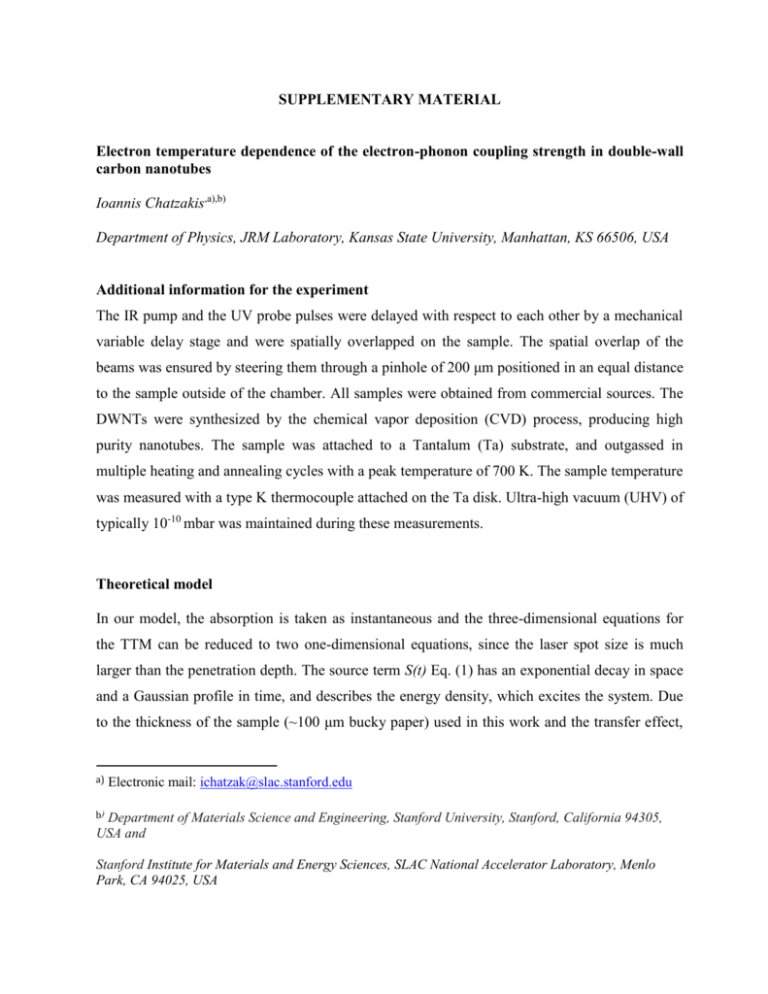
SUPPLEMENTARY MATERIAL Electron temperature dependence of the electron-phonon coupling strength in double-wall carbon nanotubes Ioannis Chatzakis,a),b) Department of Physics, JRM Laboratory, Kansas State University, Manhattan, KS 66506, USA Additional information for the experiment The IR pump and the UV probe pulses were delayed with respect to each other by a mechanical variable delay stage and were spatially overlapped on the sample. The spatial overlap of the beams was ensured by steering them through a pinhole of 200 μm positioned in an equal distance to the sample outside of the chamber. All samples were obtained from commercial sources. The DWNTs were synthesized by the chemical vapor deposition (CVD) process, producing high purity nanotubes. The sample was attached to a Tantalum (Ta) substrate, and outgassed in multiple heating and annealing cycles with a peak temperature of 700 K. The sample temperature was measured with a type K thermocouple attached on the Ta disk. Ultra-high vacuum (UHV) of typically 10-10 mbar was maintained during these measurements. Theoretical model In our model, the absorption is taken as instantaneous and the three-dimensional equations for the TTM can be reduced to two one-dimensional equations, since the laser spot size is much larger than the penetration depth. The source term S(t) Eq. (1) has an exponential decay in space and a Gaussian profile in time, and describes the energy density, which excites the system. Due to the thickness of the sample (~100 μm bucky paper) used in this work and the transfer effect, a) Electronic mail: ichatzak@slac.stanford.edu b) Department of Materials Science and Engineering, Stanford University, Stanford, California 94305, USA and Stanford Institute for Materials and Energy Sciences, SLAC National Accelerator Laboratory, Menlo Park, CA 94025, USA the electron can penetrate unhindered into larger depths, resulting in a lower energy density in the excited area. This energy density is associated with the electron temperature. Hence, the latter shows a dependence on thickness1. Thus, we avoid the underestimation of the energy deposition depth by adding the ballistic range to the optical penetration depth in the source term, S (x, t), of the TTM.2 2 4𝑙𝑛2 (1 − 𝑅) 𝑥 𝑡 𝑆(𝑥, 𝑡) = √ 𝐹 ∙ 𝑒𝑥𝑝 [− − 4𝑙𝑛2 [( ) ]] (𝛿 + 𝛿𝑏 ) 𝜋 𝑡𝑝 (𝛿 + 𝛿𝑏 ) 𝑡𝑝 ×[ 1 1−𝑒𝑥𝑝(− ], (1) 𝑑 ) 𝛿+𝛿𝑏 where R is the reflectivity, F the total energy per pulse divided by the laser spot size, tp the fullwidth half-maximum (FHWM) of the excitation pulse, δ the penetration depth (~ 17nm), δb the ballistic range (~350 nm), and d the sample thickness. The factor, 1/(1-exp(-d/δ+δb), has been incorporated into Eq. (1) to correct the finite thickness of the sample. The boundary conditions Eq. (2) (Ref. 2 second part) used neglect losses from the front and back surfaces of the sample. In the model the sides of the sample had been constrained to the ambient temperature by adopting thermal-insulation boundary conditions. Thus, the losses at the front and back surfaces of the sample have been neglected. The electron and lattice temperatures were used as the two variables for which the two-coupled equations were solved. ¶Te ¶x = x=0 ¶Te ¶x = x=d ¶Tl ¶x = x=0 ¶Tl ¶x =0 (2) x=d The initial conditions for the electron and the lattice systems were chosen as Te (x, -2tp) = Tl (x, 2tp) = 300 K, where tp is the laser pulse FWHM. The two variables, which have been used for the solution of the differential equations, are the Te and Tl. We solved numerically the model of the two coupled equations using the finite element method. The constant value of 2×1016 W/m3 for the coupling factor G(T) applied in our calculations is a common method utilized in most of the theoretical investigations. However, there is experimental evidence suggesting the constant value may be applicable for experiments using low laser intensities and low electron temperatures. The TR-TPP spectroscopy 3-5 used here enables us to study the relaxation dynamics of the charge carriers on a femtosecond timescale with very high resolution limited only by the resolution of the spectrometer. References 1 E. Knoesel, A. Hotzel, and M. Wolf, Phys. Rev. B 57, 12812 (1998). 2 J. Hohlfeld, S. S. Wellershoff, J. Gudde, U. Conrad, V. Jahnke, and E. Matthias, Chem. Phys. 251, 237 (2000); Weal M. G. Imbrahim, Hani E. Elsayed-Ali, Carl E. Bonner Jr., Michael Shinn, Interntional J. of Heat and Mass Transfer 47, 2261 (2004) 3 H. Petek and S. Ogawa. Prog. in Surface Science 56, Prog. in Surface Science 56, 239 1997). 4 A. Hagen, G. Moos, V. Talalaev, and T. Hertel, Appl. Phys. A 78, 1137 (2004). 5 T. Hertel, R. Fasel, and G. Moos, Appl. Phys. A 75, 449 (2002).







